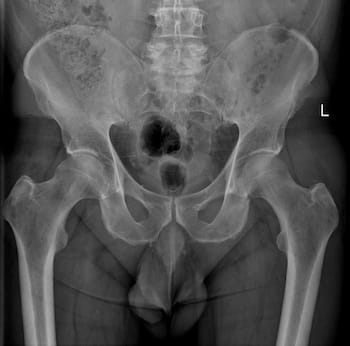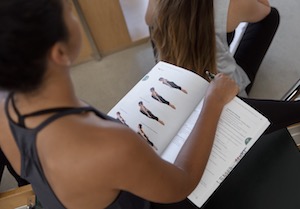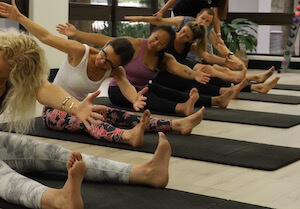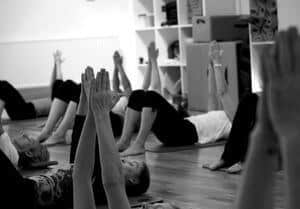Understanding the Pelvic Floor: A Key to effective Pilates Practice

Now, your pelvic floor, where exactly is it then? Imagine a sling or a hammock of muscles stretched between your sit bones and your pubic bone at the front, and your tailbone at the back.
Pamela Downey, a Board Certified Women’s Health Practitioner and Biofeedback for Pelvic Muscle Dysfunction with over 20 years of clinical experience, uses a 3D model to show these layers, explaining that the superficial layer includes muscles like the bobo cavernosus, ischiocavernosus, and superficial transverse peronei, forming the urogenital triangle. There’s also the external anal sphincter in the anal triangle. Think of these two triangles coming together to create a diamond shape, connecting your bony bits – the pubic symphysis, ischial tuberosities, and coccyx.
But it’s the deeper lot that often gets all the attention, particularly the levator anae and the coccygeus muscles. These are the chaps you might feel working when you do a Kegel or a pelvic floor muscle contraction.
Now, here’s a key bit: your pelvic floor isn’t an all-or-nothing muscle. It’s a postural muscle, made up of roughly 60% slow oxidative fibres, meaning it’s actually working at a low level (about 20-30%) most of the time, just keeping things supported as you go about your day.
Common Pelvic Floor Issues and Why They Happen
Like any other part of the body, your pelvic floor can run into a bit of trouble. Pamela Downey’s interest in this area actually came from working with individuals with neurological injuries who experienced bowel and bladder issues. But, as she points out in this Movement Mondays, plenty of able-bodied folks experience their own set of pelvic floor problems.
One of the biggies is incontinence, that unintentional leaking of urine. Often when discussing the urethral opening and the muscles surrounding it, the focus is on stress incontinence.
Stress incontinence is specifically defined as the involuntary leakage of urine that happens during activities that increase pressure in your abdomen. These activities can include things like coughing, sneezing, laughing, lifting something heavy, or exercising. The leakage occurs because the muscles supporting the urethra (the tube that carries urine out of the bladder) and the sphincter muscle that controls the flow of urine aren’t strong enough to withstand the sudden pressure.
Then there can be things like dyspareunia (painful intercourse) and prolapse of pelvic organs. These issues can stem from the pelvic floor muscles being either too weak (hypotonic) or too tight (hypertonic). Sometimes, even strong abdominal muscles can put extra pressure downwards, leading to problems if the pelvic floor isn’t supporting properly – Downey uses the analogy of “blowing out the bottom of their soda can”.
It’s interesting to note that sometimes the medical profession, with their often brief consultations, might not have the chance to delve into these sensitive and personal issues as thoroughly as a movement practitioner who spends more time with a client.
This highlights the important role Pilates teachers can play in identifying potential dysfunctions and referring clients appropriately.
How Pilates Can Lend a Helping Hand (without the forced squeezing!)
So, how can Pilates help with all this? Well, the beauty of Pilates, especially the Polestar approach, is its focus on whole-body integration, core stability, and mindful movement. Many Pilates exercises naturally encourage the engagement of the pelvic floor without needing to be explicitly told to “squeeze and lift”. Think about exercises that increase intra-abdominal pressure; these inherently challenge the pelvic floor to activate and stabilise.
Pamela Downey suggests that sometimes, rather than over-cueing a maximal contraction of the pelvic floor, which is a common instruction, it’s more beneficial to focus on the quality of the overall movement and breathing. The pelvic floor should ideally be working in a sustained way, mirroring its postural role, rather than just quick, on-off contractions (though those have their place too, like when you cough!).
In fact, here at Polestar Pilates we have moved away from heavy emphasis on volitional pelvic floor contractions in our teaching. Research suggests that simply telling someone to lift their pelvic floor doesn’t always result in the desired action – some people might even push down. “Pelvic Floor the Polestar way” lies in the belief that proper alignment and appropriate loading during exercises can elicit the correct neuromuscular response, even in those with injuries or conditions. Downey finds that exercises like standing on the reformer, with both “in” and “out” movements, can be beneficial. Addressing lumbo-pelvic hip dissociation is also key, allowing the pelvic floor to work more effectively with the surrounding muscles.
Taking the Next Step: Knowledge for Pilates Professionals
For Pilates teachers, gaining a deeper understanding of the pelvic floor is crucial for providing effective and safe instruction. This is where Continuing Education comes in handy. Courses that delve into women’s health, the abdominal wall, intra-abdominal pressure, and safe modifications for different populations, like the ones offered by Polestar Pilates, can really enhance your knowledge and confidence. Earning your CECs through such training ensures you’re equipped to work with a wider range of clients and address their needs effectively.
By understanding the anatomy, potential issues, and the subtle way Pilates can support the pelvic floor, you can make a real difference in your clients’ lives. It’s about moving away from generic cues and towards a more nuanced and informed approach.
Ready to learn more and elevate your Pilates teaching? Explore the diverse range of Continuing Education workshops and our comprehensive Pilates Teacher Training programs at Polestar Pilates. Oh, and make sure you sing up for the FREE weekly Pilates Hours with our founder and CEO, Dr. Brent Anderson. Here are two specific ones related to the above topic:
- Pilates Hour #110 – Pelvic Talk with Pam Downey and Brent Anderson
- Pilates Hour #230 – Pathokinesiology of Pelvic Floor Incontinence
Deepen your understanding of the body and become a confident and knowledgeable movement professional. Discover the Polestar Difference today!







